Analysis of Inclusive Practice in Early Years: Child A Report
VerifiedAdded on 2023/01/12
|10
|2143
|34
Report
AI Summary
This report provides a comprehensive analysis of inclusive practice within early years education, focusing on a case study of Child A, an English as an Additional Language (EAL) student with language therapy needs. The report delves into the background of inclusive practice, referencing key legislation like the Education Act of 1981 and the SEND Act of 2014, as well as the Warnock Report. It explores child development through the PILES framework (Physical, Intellectual, Language, Emotional, Social) and identifies areas of concern for Child A, particularly concerning language development. The report evaluates the effectiveness of different educational settings and the impact of the environment on a child's development process. It further examines strategies for creating an enabling environment, the importance of partnerships with parents and multi-agency teams, and the parental perspectives on inclusion, supported by questionnaire data. The report also references key legislation, including the Equality Act 2010. The conclusion emphasizes the significance of providing resources and opportunities for children with special needs, and highlights the importance of non-discrimination and the effective use of strategies such as PILES to foster child development.
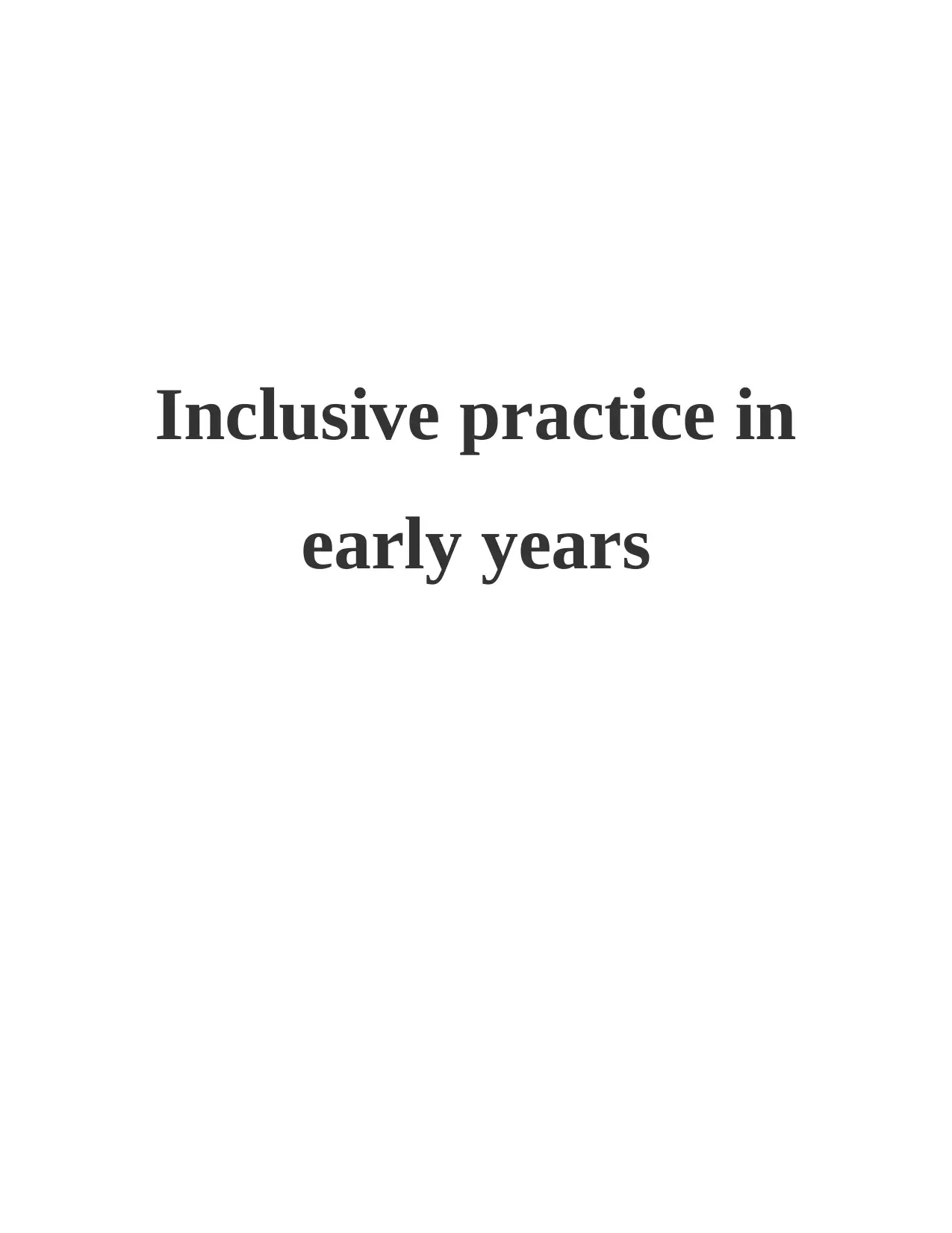
Inclusive practice in
early years
early years
Paraphrase This Document
Need a fresh take? Get an instant paraphrase of this document with our AI Paraphraser
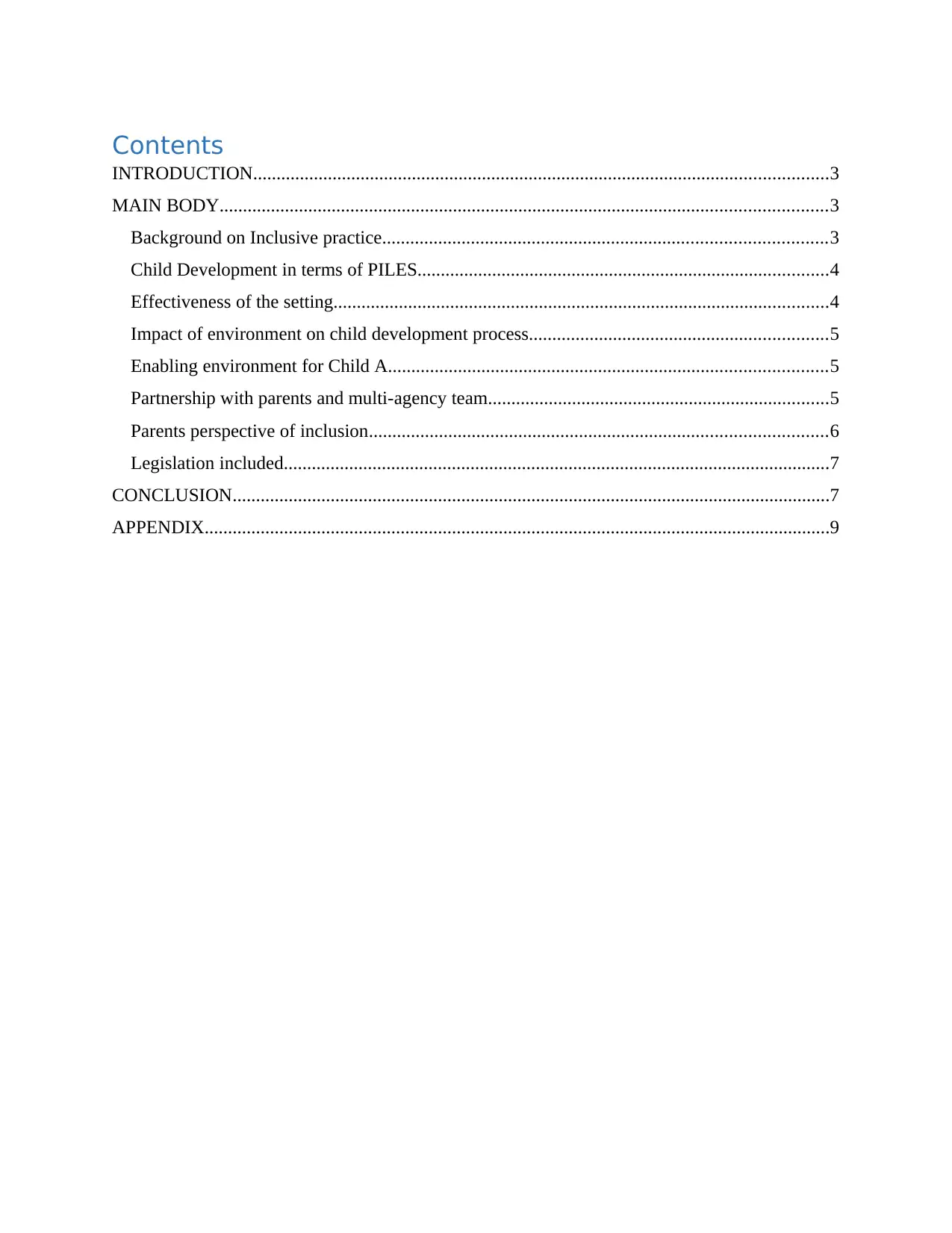
Contents
INTRODUCTION...........................................................................................................................3
MAIN BODY..................................................................................................................................3
Background on Inclusive practice...............................................................................................3
Child Development in terms of PILES........................................................................................4
Effectiveness of the setting..........................................................................................................4
Impact of environment on child development process................................................................5
Enabling environment for Child A..............................................................................................5
Partnership with parents and multi-agency team.........................................................................5
Parents perspective of inclusion..................................................................................................6
Legislation included.....................................................................................................................7
CONCLUSION................................................................................................................................7
APPENDIX......................................................................................................................................9
INTRODUCTION...........................................................................................................................3
MAIN BODY..................................................................................................................................3
Background on Inclusive practice...............................................................................................3
Child Development in terms of PILES........................................................................................4
Effectiveness of the setting..........................................................................................................4
Impact of environment on child development process................................................................5
Enabling environment for Child A..............................................................................................5
Partnership with parents and multi-agency team.........................................................................5
Parents perspective of inclusion..................................................................................................6
Legislation included.....................................................................................................................7
CONCLUSION................................................................................................................................7
APPENDIX......................................................................................................................................9
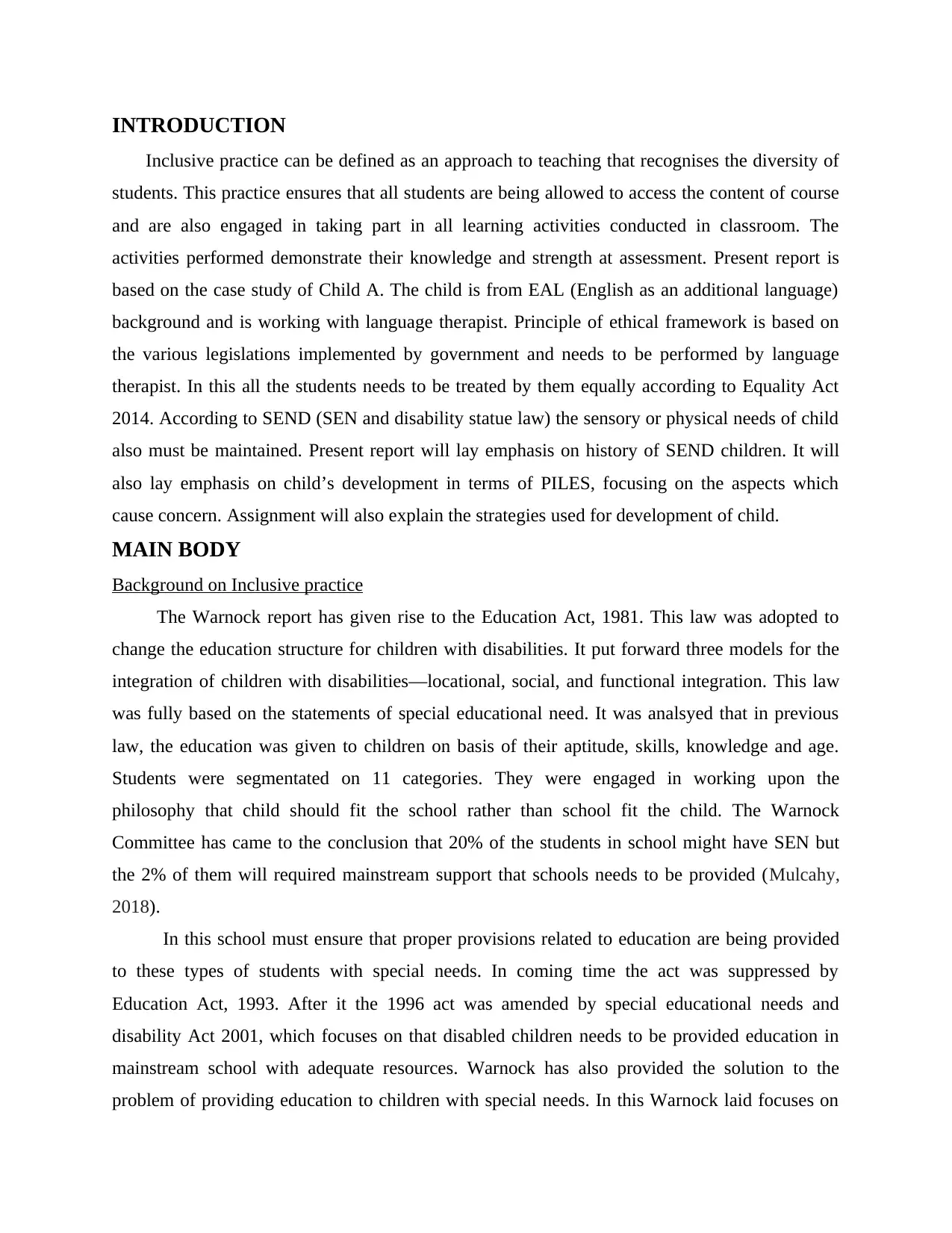
INTRODUCTION
Inclusive practice can be defined as an approach to teaching that recognises the diversity of
students. This practice ensures that all students are being allowed to access the content of course
and are also engaged in taking part in all learning activities conducted in classroom. The
activities performed demonstrate their knowledge and strength at assessment. Present report is
based on the case study of Child A. The child is from EAL (English as an additional language)
background and is working with language therapist. Principle of ethical framework is based on
the various legislations implemented by government and needs to be performed by language
therapist. In this all the students needs to be treated by them equally according to Equality Act
2014. According to SEND (SEN and disability statue law) the sensory or physical needs of child
also must be maintained. Present report will lay emphasis on history of SEND children. It will
also lay emphasis on child’s development in terms of PILES, focusing on the aspects which
cause concern. Assignment will also explain the strategies used for development of child.
MAIN BODY
Background on Inclusive practice
The Warnock report has given rise to the Education Act, 1981. This law was adopted to
change the education structure for children with disabilities. It put forward three models for the
integration of children with disabilities—locational, social, and functional integration. This law
was fully based on the statements of special educational need. It was analsyed that in previous
law, the education was given to children on basis of their aptitude, skills, knowledge and age.
Students were segmentated on 11 categories. They were engaged in working upon the
philosophy that child should fit the school rather than school fit the child. The Warnock
Committee has came to the conclusion that 20% of the students in school might have SEN but
the 2% of them will required mainstream support that schools needs to be provided (Mulcahy,
2018).
In this school must ensure that proper provisions related to education are being provided
to these types of students with special needs. In coming time the act was suppressed by
Education Act, 1993. After it the 1996 act was amended by special educational needs and
disability Act 2001, which focuses on that disabled children needs to be provided education in
mainstream school with adequate resources. Warnock has also provided the solution to the
problem of providing education to children with special needs. In this Warnock laid focuses on
Inclusive practice can be defined as an approach to teaching that recognises the diversity of
students. This practice ensures that all students are being allowed to access the content of course
and are also engaged in taking part in all learning activities conducted in classroom. The
activities performed demonstrate their knowledge and strength at assessment. Present report is
based on the case study of Child A. The child is from EAL (English as an additional language)
background and is working with language therapist. Principle of ethical framework is based on
the various legislations implemented by government and needs to be performed by language
therapist. In this all the students needs to be treated by them equally according to Equality Act
2014. According to SEND (SEN and disability statue law) the sensory or physical needs of child
also must be maintained. Present report will lay emphasis on history of SEND children. It will
also lay emphasis on child’s development in terms of PILES, focusing on the aspects which
cause concern. Assignment will also explain the strategies used for development of child.
MAIN BODY
Background on Inclusive practice
The Warnock report has given rise to the Education Act, 1981. This law was adopted to
change the education structure for children with disabilities. It put forward three models for the
integration of children with disabilities—locational, social, and functional integration. This law
was fully based on the statements of special educational need. It was analsyed that in previous
law, the education was given to children on basis of their aptitude, skills, knowledge and age.
Students were segmentated on 11 categories. They were engaged in working upon the
philosophy that child should fit the school rather than school fit the child. The Warnock
Committee has came to the conclusion that 20% of the students in school might have SEN but
the 2% of them will required mainstream support that schools needs to be provided (Mulcahy,
2018).
In this school must ensure that proper provisions related to education are being provided
to these types of students with special needs. In coming time the act was suppressed by
Education Act, 1993. After it the 1996 act was amended by special educational needs and
disability Act 2001, which focuses on that disabled children needs to be provided education in
mainstream school with adequate resources. Warnock has also provided the solution to the
problem of providing education to children with special needs. In this Warnock laid focuses on
⊘ This is a preview!⊘
Do you want full access?
Subscribe today to unlock all pages.

Trusted by 1+ million students worldwide
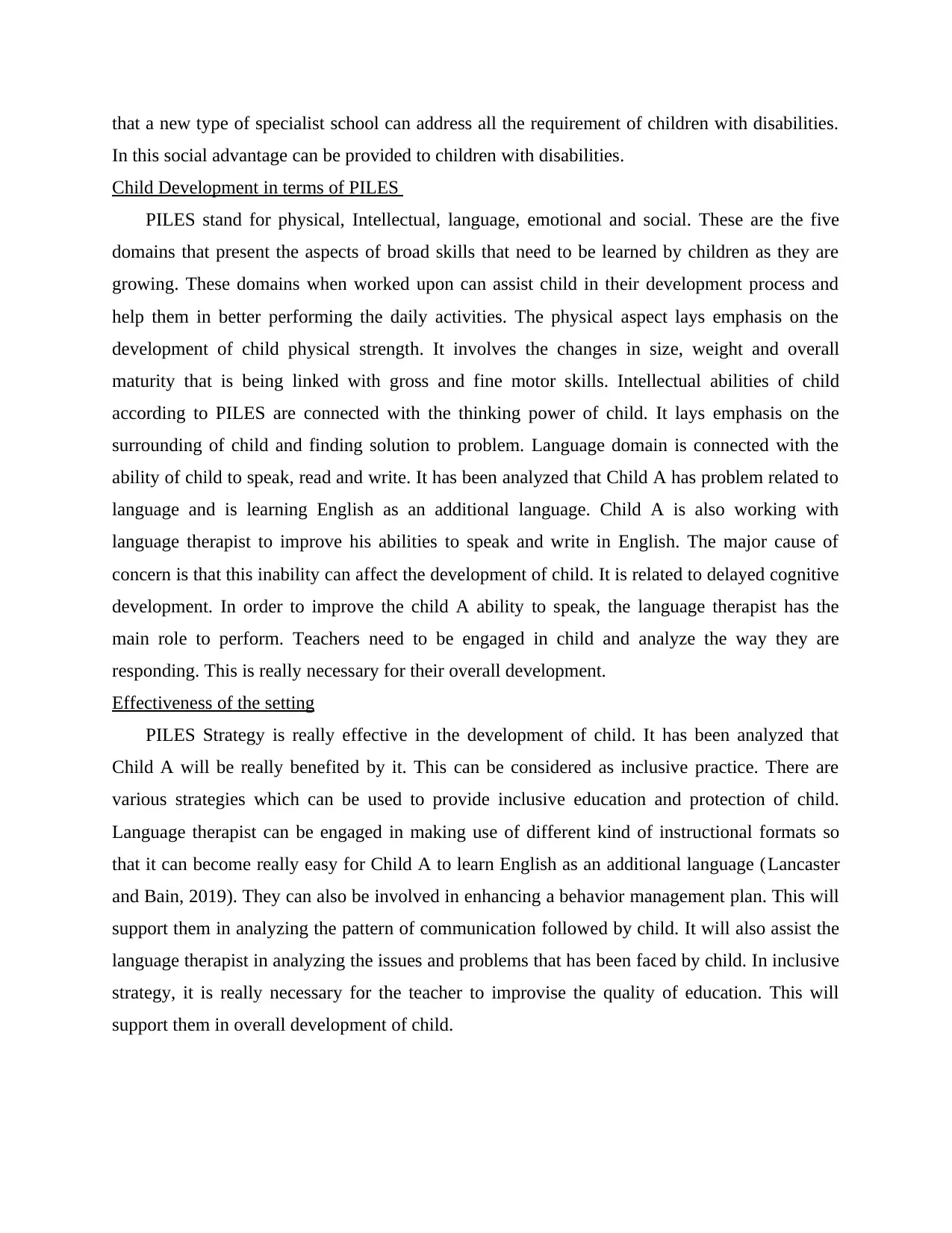
that a new type of specialist school can address all the requirement of children with disabilities.
In this social advantage can be provided to children with disabilities.
Child Development in terms of PILES
PILES stand for physical, Intellectual, language, emotional and social. These are the five
domains that present the aspects of broad skills that need to be learned by children as they are
growing. These domains when worked upon can assist child in their development process and
help them in better performing the daily activities. The physical aspect lays emphasis on the
development of child physical strength. It involves the changes in size, weight and overall
maturity that is being linked with gross and fine motor skills. Intellectual abilities of child
according to PILES are connected with the thinking power of child. It lays emphasis on the
surrounding of child and finding solution to problem. Language domain is connected with the
ability of child to speak, read and write. It has been analyzed that Child A has problem related to
language and is learning English as an additional language. Child A is also working with
language therapist to improve his abilities to speak and write in English. The major cause of
concern is that this inability can affect the development of child. It is related to delayed cognitive
development. In order to improve the child A ability to speak, the language therapist has the
main role to perform. Teachers need to be engaged in child and analyze the way they are
responding. This is really necessary for their overall development.
Effectiveness of the setting
PILES Strategy is really effective in the development of child. It has been analyzed that
Child A will be really benefited by it. This can be considered as inclusive practice. There are
various strategies which can be used to provide inclusive education and protection of child.
Language therapist can be engaged in making use of different kind of instructional formats so
that it can become really easy for Child A to learn English as an additional language (Lancaster
and Bain, 2019). They can also be involved in enhancing a behavior management plan. This will
support them in analyzing the pattern of communication followed by child. It will also assist the
language therapist in analyzing the issues and problems that has been faced by child. In inclusive
strategy, it is really necessary for the teacher to improvise the quality of education. This will
support them in overall development of child.
In this social advantage can be provided to children with disabilities.
Child Development in terms of PILES
PILES stand for physical, Intellectual, language, emotional and social. These are the five
domains that present the aspects of broad skills that need to be learned by children as they are
growing. These domains when worked upon can assist child in their development process and
help them in better performing the daily activities. The physical aspect lays emphasis on the
development of child physical strength. It involves the changes in size, weight and overall
maturity that is being linked with gross and fine motor skills. Intellectual abilities of child
according to PILES are connected with the thinking power of child. It lays emphasis on the
surrounding of child and finding solution to problem. Language domain is connected with the
ability of child to speak, read and write. It has been analyzed that Child A has problem related to
language and is learning English as an additional language. Child A is also working with
language therapist to improve his abilities to speak and write in English. The major cause of
concern is that this inability can affect the development of child. It is related to delayed cognitive
development. In order to improve the child A ability to speak, the language therapist has the
main role to perform. Teachers need to be engaged in child and analyze the way they are
responding. This is really necessary for their overall development.
Effectiveness of the setting
PILES Strategy is really effective in the development of child. It has been analyzed that
Child A will be really benefited by it. This can be considered as inclusive practice. There are
various strategies which can be used to provide inclusive education and protection of child.
Language therapist can be engaged in making use of different kind of instructional formats so
that it can become really easy for Child A to learn English as an additional language (Lancaster
and Bain, 2019). They can also be involved in enhancing a behavior management plan. This will
support them in analyzing the pattern of communication followed by child. It will also assist the
language therapist in analyzing the issues and problems that has been faced by child. In inclusive
strategy, it is really necessary for the teacher to improvise the quality of education. This will
support them in overall development of child.
Paraphrase This Document
Need a fresh take? Get an instant paraphrase of this document with our AI Paraphraser

Impact of environment on child development process
Environment has a huge impact on the development process of child. It includes the ethics,
ethos and laws that are being followed by schools and teachers during providing education to
child. From the case study it has been analyzed that Child A is suffering from language disability
and is an EAL student (Alexiadou and Essex, 2016). School must be involved in treating all the
students equally. There must be no discrimination on the basis color, age, race, physical
disabilities. Equal opportunities need to be provided to all students. This can lay positive impact
on the overall development of child. It will assist Child A in growing and improvising their
abilities linked with language development. Schools also need to adopt inclusive practice and
work towards the protection of child. They also need to increase awareness related to ones’
prejudiced thinking. School needs to make sure that they have an ethical commitment to provide
justice and fairness to all students. They also need to integrate with disabled children so that
school has a proper understanding of their nature and functioning of disability prejudice and
discrimination.
Enabling environment for Child A
For development of Child A it is really necessary to have better and supportive environment
in school. This type of environment wil assists language therapist and parents of child A in
overall development of child. If school is been involved in providing and treating all students
equally, this aspect will be really effective and will also lay positive impact on the development
of Child A. It has been analyzed that if schools are not be involved in ethical code of conduct
than it can affect development of child. They can face various health related problem and can
also face issues such as anxiety and depression. So school, needs to work towards safety and
protection of disabled child (Reiss, 2016). Proper moral education needs to be provided by
schools and colleges to everyone so that they can see disabled child as equal as other child.
Educators need to focus on marinating the self esteem of disabled children. All these aspects will
support Child A in his overall development. Scholl also needs to maintain the confidentiality; no
private information related to students should be leaked.
Partnership with parents and multi-agency team
During my tenure in order to enhance the development of Child A, I will be engaged in
working with his parents (Graham and Berman, 2019). It will assist me in improvising the
development in child. Multi-agency team can help in analyzing the issues that has been faced by
Environment has a huge impact on the development process of child. It includes the ethics,
ethos and laws that are being followed by schools and teachers during providing education to
child. From the case study it has been analyzed that Child A is suffering from language disability
and is an EAL student (Alexiadou and Essex, 2016). School must be involved in treating all the
students equally. There must be no discrimination on the basis color, age, race, physical
disabilities. Equal opportunities need to be provided to all students. This can lay positive impact
on the overall development of child. It will assist Child A in growing and improvising their
abilities linked with language development. Schools also need to adopt inclusive practice and
work towards the protection of child. They also need to increase awareness related to ones’
prejudiced thinking. School needs to make sure that they have an ethical commitment to provide
justice and fairness to all students. They also need to integrate with disabled children so that
school has a proper understanding of their nature and functioning of disability prejudice and
discrimination.
Enabling environment for Child A
For development of Child A it is really necessary to have better and supportive environment
in school. This type of environment wil assists language therapist and parents of child A in
overall development of child. If school is been involved in providing and treating all students
equally, this aspect will be really effective and will also lay positive impact on the development
of Child A. It has been analyzed that if schools are not be involved in ethical code of conduct
than it can affect development of child. They can face various health related problem and can
also face issues such as anxiety and depression. So school, needs to work towards safety and
protection of disabled child (Reiss, 2016). Proper moral education needs to be provided by
schools and colleges to everyone so that they can see disabled child as equal as other child.
Educators need to focus on marinating the self esteem of disabled children. All these aspects will
support Child A in his overall development. Scholl also needs to maintain the confidentiality; no
private information related to students should be leaked.
Partnership with parents and multi-agency team
During my tenure in order to enhance the development of Child A, I will be engaged in
working with his parents (Graham and Berman, 2019). It will assist me in improvising the
development in child. Multi-agency team can help in analyzing the issues that has been faced by

child. They can identify the problem when child is taken for routine check-up. Effective
communication with parents can help me in having an understanding about the nature and
behavior of child. By working with multi-agency and depending on the action, I referred child to
a language therapist. Yes, it is appropriate to work with parents and multi-agency for real
improvement in child. I was being able to analyze the additional needs of child A by having
communication with his parents and multi-agency team. The role of multi-agency team is to
make use of holistic approach so that proper care can be provided to children with disability.
Parents perspective of inclusion
In this questions were asked from 5 parents through questionnaire method. The results for it
include the following:
Theme 1: working with multi-agency team and teacher has helped in development of child?
Parents Number
Yes 4
No 1
Total 5
Interpretation: From the above data it has been analysed that 4 parents believe that working with
multi-agency team is really helpful for the development of child.
Theme 2: making use of inclusive practice is useful
Parents Number
Yes 3
No 2
Total 5
communication with parents can help me in having an understanding about the nature and
behavior of child. By working with multi-agency and depending on the action, I referred child to
a language therapist. Yes, it is appropriate to work with parents and multi-agency for real
improvement in child. I was being able to analyze the additional needs of child A by having
communication with his parents and multi-agency team. The role of multi-agency team is to
make use of holistic approach so that proper care can be provided to children with disability.
Parents perspective of inclusion
In this questions were asked from 5 parents through questionnaire method. The results for it
include the following:
Theme 1: working with multi-agency team and teacher has helped in development of child?
Parents Number
Yes 4
No 1
Total 5
Interpretation: From the above data it has been analysed that 4 parents believe that working with
multi-agency team is really helpful for the development of child.
Theme 2: making use of inclusive practice is useful
Parents Number
Yes 3
No 2
Total 5
⊘ This is a preview!⊘
Do you want full access?
Subscribe today to unlock all pages.

Trusted by 1+ million students worldwide
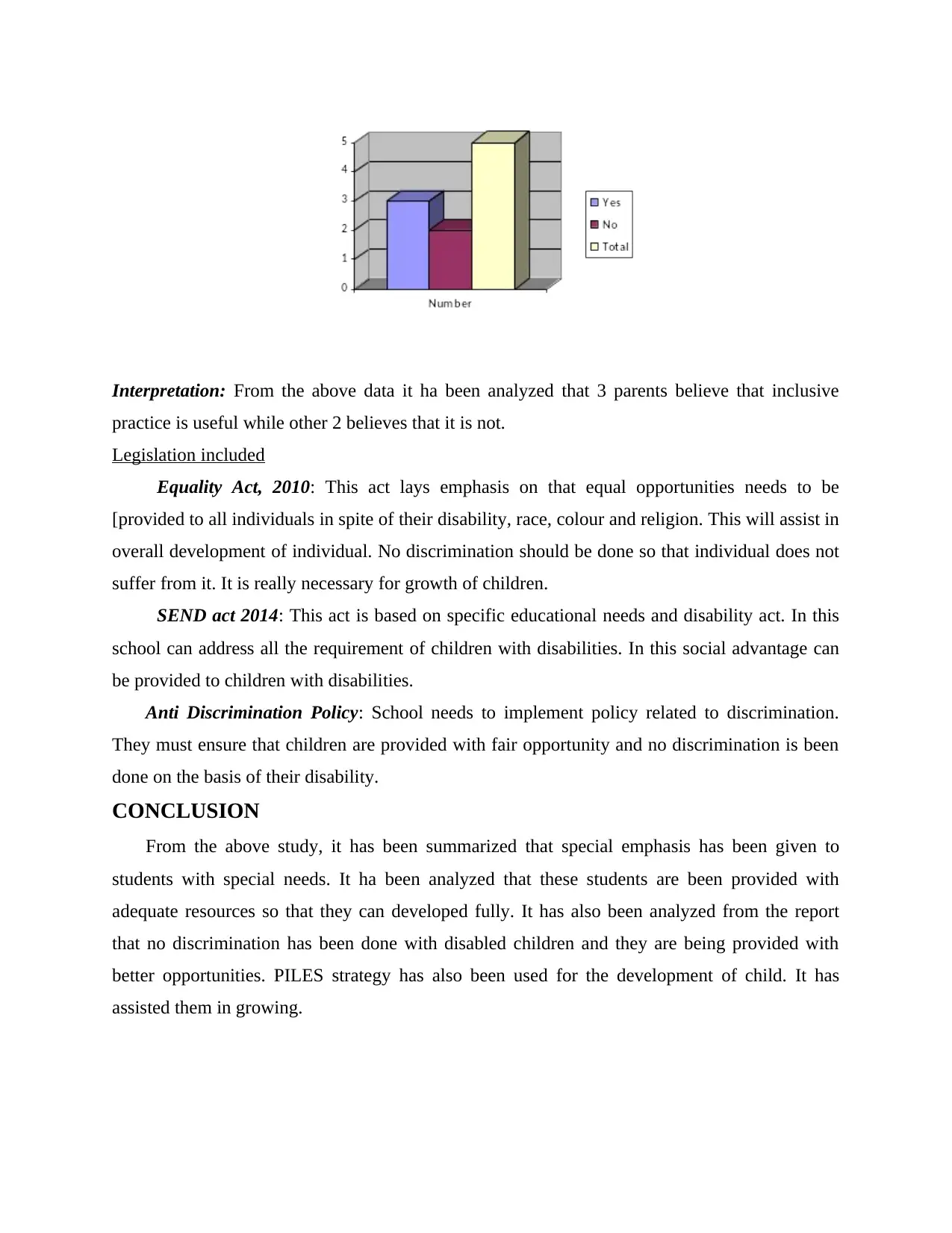
Interpretation: From the above data it ha been analyzed that 3 parents believe that inclusive
practice is useful while other 2 believes that it is not.
Legislation included
Equality Act, 2010: This act lays emphasis on that equal opportunities needs to be
[provided to all individuals in spite of their disability, race, colour and religion. This will assist in
overall development of individual. No discrimination should be done so that individual does not
suffer from it. It is really necessary for growth of children.
SEND act 2014: This act is based on specific educational needs and disability act. In this
school can address all the requirement of children with disabilities. In this social advantage can
be provided to children with disabilities.
Anti Discrimination Policy: School needs to implement policy related to discrimination.
They must ensure that children are provided with fair opportunity and no discrimination is been
done on the basis of their disability.
CONCLUSION
From the above study, it has been summarized that special emphasis has been given to
students with special needs. It ha been analyzed that these students are been provided with
adequate resources so that they can developed fully. It has also been analyzed from the report
that no discrimination has been done with disabled children and they are being provided with
better opportunities. PILES strategy has also been used for the development of child. It has
assisted them in growing.
practice is useful while other 2 believes that it is not.
Legislation included
Equality Act, 2010: This act lays emphasis on that equal opportunities needs to be
[provided to all individuals in spite of their disability, race, colour and religion. This will assist in
overall development of individual. No discrimination should be done so that individual does not
suffer from it. It is really necessary for growth of children.
SEND act 2014: This act is based on specific educational needs and disability act. In this
school can address all the requirement of children with disabilities. In this social advantage can
be provided to children with disabilities.
Anti Discrimination Policy: School needs to implement policy related to discrimination.
They must ensure that children are provided with fair opportunity and no discrimination is been
done on the basis of their disability.
CONCLUSION
From the above study, it has been summarized that special emphasis has been given to
students with special needs. It ha been analyzed that these students are been provided with
adequate resources so that they can developed fully. It has also been analyzed from the report
that no discrimination has been done with disabled children and they are being provided with
better opportunities. PILES strategy has also been used for the development of child. It has
assisted them in growing.
Paraphrase This Document
Need a fresh take? Get an instant paraphrase of this document with our AI Paraphraser

REFERENCES
Books and Journals
Graham, L. and Berman, J., 2019. Inclusive Practice Through Layers of Learning Intervention.
In Inclusion, Equity and Access for Individuals with Disabilities (pp. 479-495). Palgrave
Macmillan, Singapore.
Reiss, M.J., 2016. Religious diversity and inclusive practice. In Key Issues for Teaching
Assistants (pp. 52-62). Routledge.
Lancaster, J. and Bain, A., 2019. Designing University Courses to Improve Pre-Service
Teachers' Pedagogical Content Knowledge of Evidence-Based Inclusive
Practice. Australian Journal of Teacher Education, 44(2), p.4.
Peer, L. and Reid, G. eds., 2016. Special educational needs: A guide for inclusive practice. Sage.
Alexiadou, N. and Essex, J., 2016. Teacher education for inclusive practice–responding to
policy. European Journal of Teacher Education, 39(1), pp.5-19.
Mulcahy, K., 2018. Reflecting social change: Father-inclusive practice. Every Child, 24(3), p.31.
Books and Journals
Graham, L. and Berman, J., 2019. Inclusive Practice Through Layers of Learning Intervention.
In Inclusion, Equity and Access for Individuals with Disabilities (pp. 479-495). Palgrave
Macmillan, Singapore.
Reiss, M.J., 2016. Religious diversity and inclusive practice. In Key Issues for Teaching
Assistants (pp. 52-62). Routledge.
Lancaster, J. and Bain, A., 2019. Designing University Courses to Improve Pre-Service
Teachers' Pedagogical Content Knowledge of Evidence-Based Inclusive
Practice. Australian Journal of Teacher Education, 44(2), p.4.
Peer, L. and Reid, G. eds., 2016. Special educational needs: A guide for inclusive practice. Sage.
Alexiadou, N. and Essex, J., 2016. Teacher education for inclusive practice–responding to
policy. European Journal of Teacher Education, 39(1), pp.5-19.
Mulcahy, K., 2018. Reflecting social change: Father-inclusive practice. Every Child, 24(3), p.31.
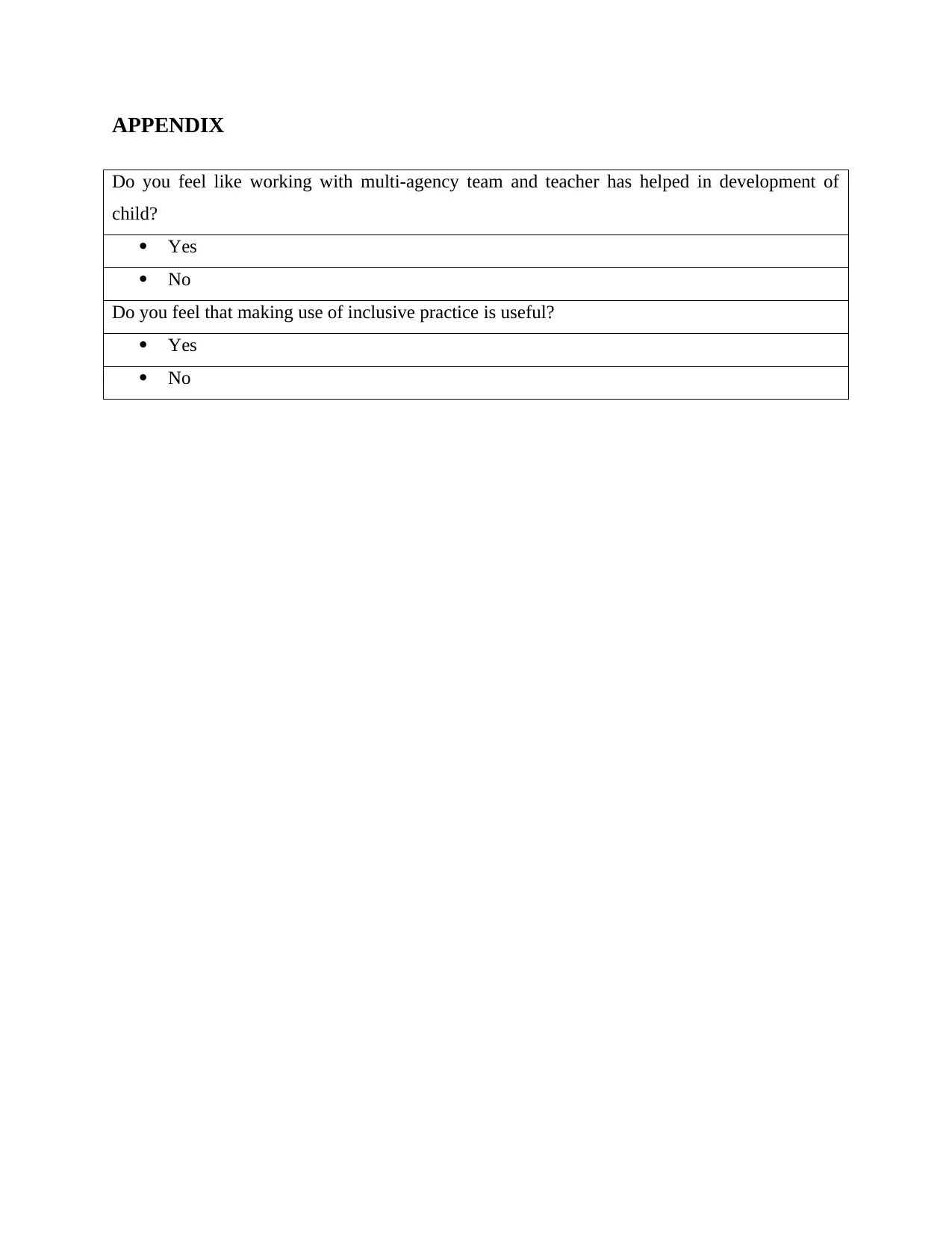
APPENDIX
Do you feel like working with multi-agency team and teacher has helped in development of
child?
Yes
No
Do you feel that making use of inclusive practice is useful?
Yes
No
Do you feel like working with multi-agency team and teacher has helped in development of
child?
Yes
No
Do you feel that making use of inclusive practice is useful?
Yes
No
⊘ This is a preview!⊘
Do you want full access?
Subscribe today to unlock all pages.

Trusted by 1+ million students worldwide

1
1 out of 10
Related Documents
Your All-in-One AI-Powered Toolkit for Academic Success.
+13062052269
info@desklib.com
Available 24*7 on WhatsApp / Email
![[object Object]](/_next/static/media/star-bottom.7253800d.svg)
Unlock your academic potential
Copyright © 2020–2025 A2Z Services. All Rights Reserved. Developed and managed by ZUCOL.





